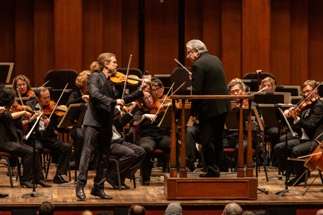|
Back
Vaulting Ambition and a Fond Farewell Washington
The Kennedy Center
03/23/2019 - & March 19 (Seattle), 21 (Kansas City), 2019
Michael Tilson Thomas: Agnegram
Wolfgang Amadeus Mozart: Violin Concerto No. 3 in G major, K. 216
Ludwig van Beethoven: Symphony No. 3 in E-flat major “Eroica”, Op. 55
Christian Tetzlaff (violin)
San Francisco Symphony, Michael Tilson Thomas (conductor)

C. Tetzlaff, M. Tilson Thomas (© Kim Huynh)
When Michael Tilson Thomas steps down in 2020 as Music Director of the San Francisco Symphony, he will have spent a total of 25 years at the helm of that orchestra, making his an unusually long directorship by current standards. I have not generally followed his tenure in San Francisco, but one has to admire such dedication to a single ensemble over time. Saturday’s concert, under the aegis of the Washington Performing Arts Association, is to be Tilson Thomas’s final appearance in Washington, DC as the orchestra’s director, and for it the conductor, who has throughout his career been associated mainly with either Mahler or modern American music, took a somewhat different turn and concentrated mostly on the Viennese classics. The program commenced, however, with a brief work composed by Tilson Thomas himself, originally for the 90th birthday of now-deceased SFS board member Agnes Albert. Taking a cue from Bach and Shostakovich, among other, the piece is built upon a translation of Agnes Albert’s name into solfege. Yet Tilson Thomas goes a step further by excluding any notes not found in the name from the melodic material! If this was a gimmick, it did not seem to interfere with the enjoyability of the work, which is jazzy, upbeat, and not without charm, if arguably a bit over-scored at times.
This was followed by Mozart’s Violin Concerto in G major, featuring as soloist the distinguished German violinist Christian Tetzlaff (who, incidentally, played along with the first violins during purely orchestral passages—something I have never seen before, and a nice gesture.) In the past I have found some of Tetzlaff’s Mozart to be too mannered and not very lyrical, but his performance here was on the whole a success. Although he did not always project very loudly above the orchestra—which took a bit of time to warm up in the first movement but soon enough settled into an assured and musical performance of the rest of the piece—he seemed determined to bring an extra degree of drama and character to early(ish) Mozart. One might question the suitability of such a serious reading of what is at heart a Gallant work, and there were moments in which I felt Tetzlaff attacked too aggressively (mainly in the first movement) or exaggerated dynamic contrasts; worse, there were a couple of occasions in the first movements where his forward drive brought him out-of-sync with the orchestra. Yet as a whole the effect was satisfying, perhaps especially in the final movement; one sensed the violist striving to make the work his own and succeeding more often than not.
The “Eroica” Symphony was surely the great conducting challenge of the evening, and fortunately Tilson Thomas made a really striking impression here. For all its popularity, this is not an easy work to interpret. Nowhere else, I think, is Beethoven so obviously pushing the basic classical form to its limits, and one can sense the growing pains here rather more keenly than in the longer and more ambitious yet also more majestic and assured Ninth Symphony. The most effective performances of the Eroica must nearly burst their seams, balancing sustained drama with a touch of elegance.
Tilson Thomas achieved this sense of Napoleonic “vaulting ambition” not only by paying ample attention to dynamic contrasts but also by pushing the orchestra to its technical limits, especially in an almost explosive first movement, taken fast but not quite breathlessly, thus allowing the drama to be complemented by a certain amount of lyricism. The “Funeral March” was touching and introspective without becoming too languid; one especially effective touch could be heard in the passage leading up to the great double fugue at the center of the movement, which was played in a sustained hush of anticipation. And the Finale, arguably the most cumulatively impressive and assured of the work’s four movements, came off with the same blend of drama, weight, and musicality that characterized the first movement, although ensemble was perhaps a bit cleaner here. I must confess, however, that at times during the outer movements I missed some of the extra warmth and refinement the great European orchestras—not to mention America’s Boston Symphony Orchestra—can bring to this music. The SFS is a fine orchestra with many accomplished players and a basically full and secure ensemble sound, but horns and especially strings displayed occasional tuning problems and lacked that special glow that can take off a bit of the young Beethoven’s edge. Yet on the whole, this was a distinguished Eroica and a fine testimony to the abilities of an American conducting icon. (The encore was one of the less ubiquitous of Brahms’s Hungarian Dances.)
Samuel Wigutow
|